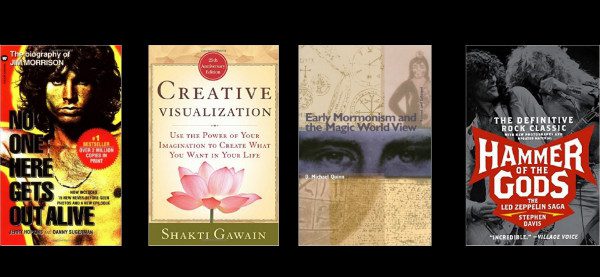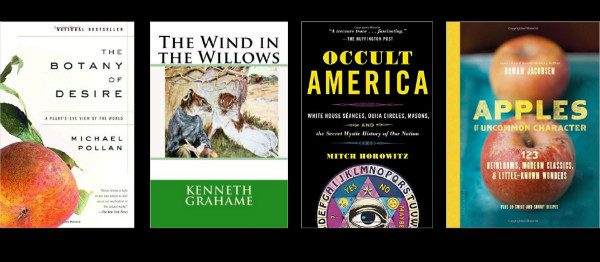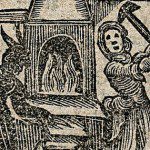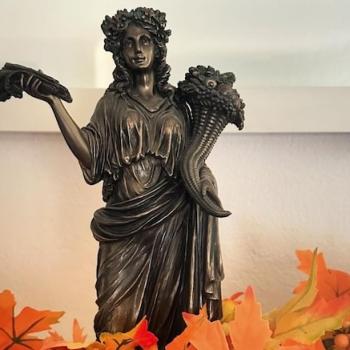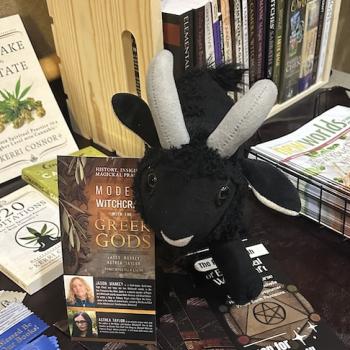Apparently these lists of “5 Non Books” are a thing, and since I was asked to play along I thought I would. Since I don’t see all of these books I’m going to list as essential parts of a Pagan path, I kept this list specific to Witches. Thanks to Gwion for starting the trend and to John for continuing it, and to Tempest who we just know is going to do one of these lists herself!
To be honest, coming up with a list of five “non-whatever” books was tough for me. I fell in love with the gods of Greece back in elementary school, and that love of the fantastical and wondrous stayed with me as I read C.S. Lewis, Lloyd Alexander, and later Raymond Feist. I love high-Fantasy but I don’t think it’s essential Witch reading. Similarly, almost all of the magical books I’ve read came after my conversion so to speak.
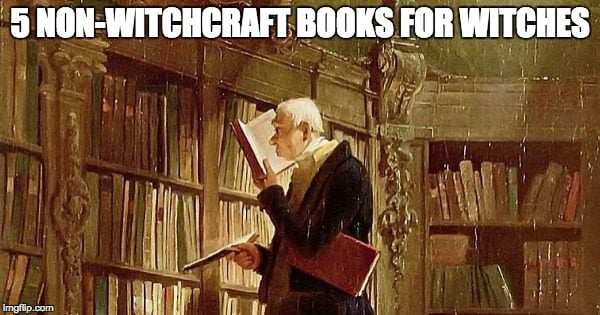
HAMMER OF THE GODS: THE LED ZEPPELIN STORY by Stephen Davis and NO ONE HERE GETS OUT ALIVE by Jerry Hopkins and Danny Sugarman
Led Zeppelin and The Doors are not essential Witch reading for most people, and if you find yourself scratching your head because of these selections you certainly aren’t alone. However, both books introduced new worlds and ways of thinking to me before I was in the Craft. While both Hammer and Alive aren’t really the best books on their respective subjects, they are the best myth-making books on Led Zeppelin and the Doors. Ever wondered how to become larger than life? Davis and Hopkins have it covered.
Let’s start with Hammer of the Gods. Hammer didn’t introduce me to Aleister Crowley, but it did make me interested in Crowley, and this book and the music of Zeppelin are partly why I’m here today. Secondly, Hammer places Robert’s Plant Celtic and counter-culture lyrical noodlings and builds a 1970’s world around them. Though this book doesn’t have Witchcraft in it, it made me ready for Witchcraft. The 1970’s world of Zeppelin has a lot of overlap with the occult streams that would influence Witchcraft and Paganism down the road.
One of the things that makes for an effective ritualist in my humble opinion, is a sense of presence, and nobody had more presence than Jim Morrison (well, with the possible exception of David Bowie). Rock stars know how to command a space, something every Witch should know too! Diving into the mind of a rockstar is a way to help capture that attitude and swagger. Do you need to read about Jimmy Page and Jim Morrison in order to accomplish that? Of course not, lots of other rock-gods and just plain normal people have “it” too, but I think they are a good place to start. I’ve also always felt as if Jim Morrison was channeling (or drawing down) Dionysus during a lot of his stage performances, so if you are interested in such interactions on deity reading about Jim certainly doesn’t hurt.
CREATIVE VISUALIZATION by Shakti Gawain
The most important magickal skill for the developing Witch is creative visualization. If one can’t see what they want, they’ll never be able to make that thing manifest in their daily life. Gawain’s book is all about how to paint that mental picture in your mind and then channel it into something powerful.
Creative visualization is about more than getting what you want; it calms, centers, and focuses when you are running out of patience. Simply visualizing a something and sending that out into the universe is the basic building of all magical practice. In circle I use creative visualization from start to finish, visualizing the power of my athame, the presence of the quarters, and using it to focus myself when we open our rites or are grounding. I’d probably recommend this book before a Witchcraft book if I’m being totally honest.
EARLY MORMONISM & THE MAGICAL WORLD VIEW by D. Michael Quinn
Ignore the first half of this book’s title and focus on that last part: magical world view. What makes this book so important is just how completely Quinn captures the magical world of early America. Despite what we are taught in our schools, people were practicing all sorts of magic in the 19th Century, and reading lots of magical books too! And the early Mormons and their founder Joseph Smith were especially interested in those things, and practiced them.
But it’s not just the magical stuff that’s interesting, there’s the influence of fraternal orders like the Freemasons. Witches aren’t the only ones to mine the work of the Masons for their rites, the Mormons did it too (though I think we’ve done it better). Quinn sorts through all sorts of books and newspapers clippings to paint a complete picture of a truly occult America. Love it.
If Quinn is a little intimidating, there are other options here. Michael Horowitz’s Occult America: White House Seances, Ouija Circles, Masons, and the Secret Mystic History of Our Nation is a fun “dip your toe in the water” sort of book about America’s occult past. Unless you are an academic, I think it’s worth reading too.
THE WIND IN THE WILLOWS by Kenneth Grahame
Is including The Wind in the Willows here cheating? I’ve written extensively about it in the past, but with several hundred articles already on this blog, it should’t be a real surprise that some of the things in an article like this have popped up here before.
For the last twelve years I’ve been facilitating workshops on the worship of Pan in Ancient Greece and his re-emergence in the Modern World. I’ve typically finished my lectures on Pan with a bit from the seventh chapter of Willows entitled The Piper at the Gates of Dawn, and to this day it still gets to me. I know that the Pan of Arcadian Greece still plays his pan-pipes, but Grahame’s modern understanding of Pan most directly illustrates the god who stole my heart. It’s Pan at his very best. He’s powerful, vulnerable, and his tune is the very song of Nature. There are things like it in English literature, but nothing as beautiful, and it can all be found in a beloved “children’s book.”
As a Horned God worshipping Witch, Grahame’s Pan is my favorite modern interpretation of the god. Throughout Piper, the reader can nearly hear the heartbeat of the Horned One as the book’s protagonist’s slowly walk into his presence. It’s like poetry, and it never gets old.
If you’ve already read Willows and want something else that’s also pretty Pan like, look no further than Tom Robbins’ Jitterbug Perfume. I don’t like how the story ends, but the journey is worth taking. Coincidently one of the passages from Perfume is what I open up my Horned God lectures with!
THE BOTANY OF DESIRE by Michael Pollan
As a Witch I have a strong connection with the natural world, but it’s one that’s often tested. It’s easy to forget about the magick that can be found in our own backyards or a nearby park. What I love so much about The Botany of Desire, is that Pollan expertly and completely captures the wonder of the natural world. Pollan’s book is set up around the interactions between humans and four specific plants (apples, tulips, marijuana, and potatoes). Three of those (don’t forget potato vodka) are capable of transforming the mind through chemical processes, and one of them transforms the mind through its sheer beauty.
Before reading Botany I’d sort of let my gardening and my curiosity of the plant kingdom lapse, but Pollan reinvigorated it. I’m probably never going to have a grove of apple trees, but I can explore the hundreds of varieties of apple beyond the Red Delicious (which is red, but not delicious). I’ve never been much into marijuana, but intoxicants are a part of Witchcraft for many (though certainly not all). Even better this book is intensely readable and contains a fascinating tidbit or fact on almost every page.
If you find yourself fascinated by apples after reading Botany (and you will), pick up Apples of Uncommon Character by Rowan Jacobsen. Jacobsen shares the history of more than 100 apples in his book, with gorgeous full color photographs of every apple covered. I keep a list with me when I travel in the fall with the hope that I might try all of the apples listed in this book.
(And yeah, I can count, I know that I’ve actually listed nine books here, but it’s hard to pick these things!)


